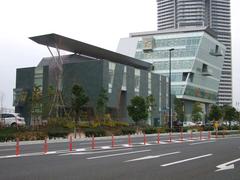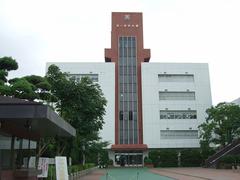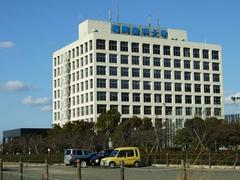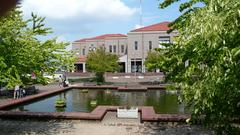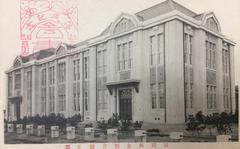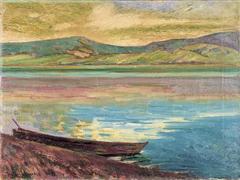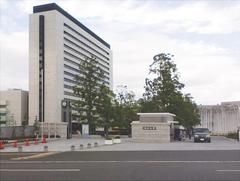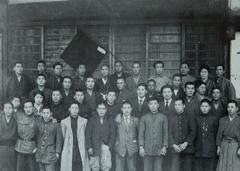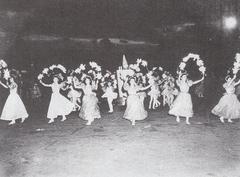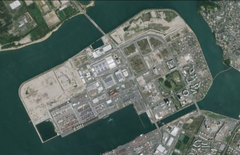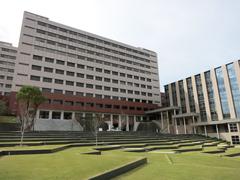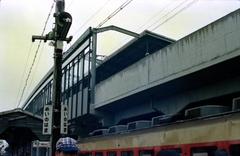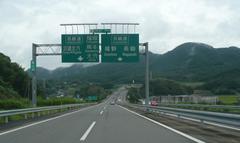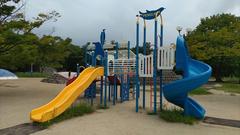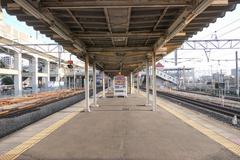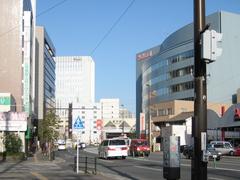Akasaka Station Visiting Hours, Tickets, and Travel Guide: Fukuoka Historical Sites
Date: 04/07/2025
Introduction: The Gateway to Fukuoka’s Heritage
Akasaka Station, located in the heart of Fukuoka’s Chūō Ward, serves as an essential starting point for exploring the city’s rich historical and cultural landscape. Since its opening in 1981 on the Fukuoka City Subway Kūkō Line, Akasaka Station has offered convenient access to both commuters and visitors. From here, travelers can easily reach iconic sites such as the Fukuoka Castle ruins in Maizuru Park and the tranquil beauty of Ohori Park, while immersing themselves in a district with a legacy dating back to the Yayoi Period (gofukuoka.jp, Japan Talk).
Akasaka’s infrastructure is designed for accessibility, featuring multilingual ticket machines, barrier-free facilities, and seamless connections to major civic and cultural sites. Whether you’re drawn to the vibrant cherry blossoms, Fukuoka’s samurai heritage, or the lively shopping and dining of the Tenjin and Nagahama districts, Akasaka Station is the perfect launchpad for your Fukuoka adventure.
This guide provides essential information on Akasaka Station’s visiting hours, ticketing, accessibility, nearby attractions, and practical tips to ensure a rewarding visit (Fukuoka Now, Living Nomads).
Table of Contents
- Early Development of the Akasaka Area
- The Castle Town and Urban Growth
- Akasaka Station: Birth and Visitor Information
- Key Historical Landmarks Near Akasaka Station
- Special Events, Tours, and Photographic Hotspots
- Akasaka’s Modern Role and Urban Renewal
- Historical Walking Routes from Akasaka
- Practical Visitor Guide: Facilities & Tips
- Frequently Asked Questions (FAQ)
- Conclusion & Call to Action
Early Development of the Akasaka Area
Akasaka’s history stretches back over two millennia. Archaeological finds from the Yayoi Period show early settlement and cultivation, with the Itazuke Ruins nearby offering evidence of large, moated villages and some of Japan’s earliest paddy fields (gofukuoka.jp). During the Edo Period, Akasaka became the residential quarter for samurai, merchants, and artisans supporting Fukuoka Castle, built by Kuroda Nagamasa in the early 1600s (Japan Talk).
The Castle Town and Urban Growth
Fukuoka’s prosperity as a castle town in the Edo Period shaped the district’s urban structure. Roads radiated from the castle, and neighborhoods reflected social hierarchies. With the Meiji Restoration and the 1889 merger of Fukuoka and Hakata, Akasaka became integral to the rapidly modernizing city, balancing urban growth with the preservation of its historic core (gofukuoka.jp).
Akasaka Station: Birth and Visitor Information
Opened in 1981, Akasaka Station supports Fukuoka’s growing commercial and residential needs (Wikipedia). Its strategic location adjacent to major administrative buildings and parks has made it a key access point for both daily commuters and tourists.
Visiting Hours and Tickets
- Operating Hours: 5:30 AM – Midnight (varies slightly by direction; confirm with Fukuoka City Subway)
- Ticketing: Automated machines accept cash and IC cards (Suica, ICOCA, Nimoca). Options include single tickets, day passes, and the Fukuoka Tourist City Pass, which covers subways, buses, and ferries (Fukuoka Now, MyTravelBuzzG).
- Multilingual Support: Machines and signage in Japanese, English, Korean, and Chinese.
Accessibility
Akasaka Station is fully barrier-free, with elevators, tactile paving, and accessible restrooms. The platform-train gap is minimized for wheelchair users (Smooth Metro).
Key Historical Landmarks Near Akasaka Station
Fukuoka Castle Ruins (Maizuru Park)
A 10–15 minute walk from the station, Maizuru Park is home to the extensive ruins of Fukuoka Castle, Kyushu’s largest castle in its day. Explore evocative stone walls, gates, and panoramic viewpoints, especially stunning during cherry blossom season (March–April) (Japan Talk). Access is free, and the park is open year-round.
Ohori Park
Adjacent to Maizuru Park, Ohori Park features a large pond, Japanese gardens, and a scenic jogging path. The park is open 24 hours, with pedal boat rentals available during the day (Living Nomads).
Fukuoka Art Museum
Located within Ohori Park, the museum boasts a collection of Asian and contemporary art, including works by Salvador Dalí. Open 9:30 AM–5:30 PM (closed Mondays), with admission generally between 200–500 yen (Living Nomads).
Terumo Shrine
Nestled inside Maizuru Park, Terumo Shrine honors the Kuroda clan and offers a peaceful setting for reflection (Fukuoka Now).
Special Events, Tours, and Photographic Hotspots
- Hakata Gion Yamakasa Festival (July): UNESCO-recognized, with lively float races and traditional music (Japan Travel).
- Fukuoka Castle Cherry Blossom Festival (Spring): Hanami parties under blooming sakura in Maizuru Park.
- Guided Walking Tours: Explore the castle ruins, Ohori Park, and Hakata Old Town with local guides.
- Photographic Spots: Capture cherry blossoms, castle walls, and tranquil park scenes.
Akasaka’s Modern Role and Urban Renewal
Akasaka today blends history with contemporary life. It hosts stylish cafés, boutiques, and is close to Nagahama’s famous yatai food stalls. The district’s urban renewal integrates new developments with respect for historic structures and green spaces (gofukuoka.jp).
Historical Walking Routes from Akasaka
Self-guided walks from Akasaka Station take you to Maizuru Park, then onward to Ohori Park and Tenjin’s shopping district, or further by subway to Hakata’s ancient temple streets (the6and7.com).
Practical Visitor Guide: Facilities & Tips
Station Layout and Amenities
- Platform: Single island platform serving two tracks (Wikipedia).
- Elevators & Escalators: Ensure easy access.
- Restrooms: Clean and accessible.
- Vending Machines: Snacks and drinks.
- Information Displays: Real-time schedules in English and Japanese.
- Bike Sharing: “Charichari” stations nearby (Fukuoka Now).
- Safety: Surveillance cameras, emergency intercoms, and proximity to police.
Transportation Tips
- From Fukuoka Airport: ~15 minutes by subway (Living Nomads).
- To Tenjin Shopping: 1 stop or a 15-minute walk.
- To Ohori & Maizuru Parks: 5–10 minute walk.
Accessibility
All facilities are designed for universal access. Look for universal symbols and multilingual signage.
Frequently Asked Questions (FAQ)
Q: What are Akasaka Station’s operating hours?
A: Approximately 5:30 AM to midnight; check the latest subway schedules.
Q: How do I buy tickets?
A: Use automated machines (cash/IC cards) with multilingual support; consider day or tourist passes.
Q: Are there entrance fees for nearby attractions?
A: Maizuru Park and Fukuoka Castle ruins are free; Fukuoka Art Museum charges admission.
Q: Is the station accessible for wheelchair users?
A: Yes—elevators, tactile paving, and accessible restrooms are available.
Q: When is the best time to visit the castle ruins?
A: Spring (cherry blossoms) and autumn (foliage) are most popular.
Conclusion
Akasaka Station is far more than a transit hub—it is your gateway to Fukuoka’s captivating blend of historic sites, lush parks, vibrant festivals, and urban culture. Its modern facilities, central location, and easy access to major attractions make it ideal for both tourists and locals. For the latest updates, travel tips, and personalized itineraries, download the Audiala app and follow us on social media.
Sources and Further Reading
- A Comprehensive Guide to Akasaka Station and Fukuoka Historical Sites: Visiting Hours, Tickets, and Attractions, 2025
- Fukuoka Castle Ruins, Japan Talk, 2025
- Akasaka Station (Fukuoka) Wikipedia, 2025
- Fukuoka Now - West Coast Course, 2025
- Living Nomads - Best Places to Visit in Fukuoka, 2025
- Japan Travel - Hakata Gion Yamakasa Festival, 2025
- MyTravelBuzzG - Fukuoka Itinerary Travel Guide Blog, 2025
- Smooth Metro Guide
- Fukuoka City Subway Route Map
- Japan Travel Navitime: Akasaka Station
- the6and7.com: Fukuoka 4-Day Itinerary
- Asian Wanderlust: Fukuoka
- Fun Japan: Fukuoka Festivals
- Hey Roseanne: Fukuoka Itinerary

